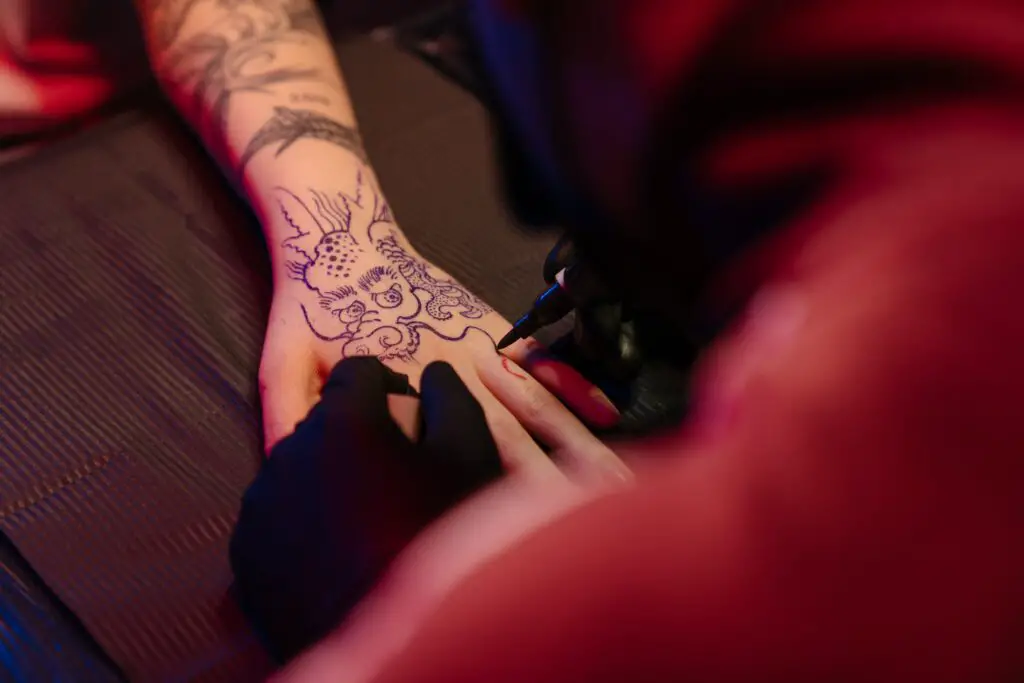Contents
Can I put saniderm on a week-old tattoo?
Tattoos are not just ink on skin; they are artistic expressions that require careful attention and nurturing to ensure optimal healing and vibrancy. The significance of proper tattoo aftercare cannot be overstated, as it directly influences the final outcome of this unique form of self-expression. As individuals navigate the intricacies of caring for their new tattoos, a common question emerges: “Can I put Saniderm on a week old tattoo?” In this exploration, we delve into the fundamental importance of effective aftercare and specifically address the query surrounding the use of Saniderm during the critical first week of the tattoo healing process. Understanding this balance is key to both preserving the beauty of the artwork and fostering a comfortable and successful healing experience.
Understanding Saniderm and its Purpose
Tattoo aftercare has evolved over the years, and one notable addition to the repertoire is Saniderm—a transparent film dressing designed to revolutionize the healing process.
Explanation of Saniderm as a Transparent Film Dressing:
Saniderm is a thin, flexible film that acts as a protective barrier over fresh tattoos. Composed of medical-grade material, this transparent dressing adheres to the skin, creating a shield against external contaminants while allowing the tattoo to breathe. It essentially functions as a second skin, providing a controlled healing environment.
Overview of its Role in Tattoo Aftercare and Benefits:
The primary purpose of Saniderm in tattoo aftercare is to streamline the healing process. By creating a barrier between the tattoo and the external environment, Saniderm helps reduce the risk of infections and shields the tattoo from friction and irritation. Its benefits include locking in the body’s natural healing fluids, promoting a moist healing environment, and minimizing scabbing. Additionally, Saniderm provides a level of protection against clothing and other potential irritants, making it an appealing option for those seeking a convenient and hassle-free aftercare solution.
As we delve deeper, we’ll explore the suitability of applying Saniderm to a week old tattoo, considering the nuances of the healing timeline and individual variations in skin response.

The General Timeline for Tattoo Healing
Understanding the stages of tattoo healing is crucial for making informed decisions about aftercare practices. Let’s explore the typical timeline during the critical first week and underscore the importance of allowing the tattoo to breathe.
Brief Discussion on the Typical Stages of Tattoo Healing During the First Week:
In the initial days following the application of a tattoo, the body initiates a natural healing process. The first stage involves the formation of a protective scab as the skin begins to repair itself. This is often accompanied by mild redness and swelling. As the week progresses, the tattooed area may start to peel, revealing the underlying layers of healed skin.
Introduction to the Importance of Allowing the Tattoo to Breathe During the Initial Phase:
Allowing the tattoo to breathe during the initial phase of healing is a key consideration. Oxygen plays a vital role in the skin’s regenerative process, and undue compression or occlusion can impede this natural exchange. While certain aftercare methods, including Saniderm, may provide a protective barrier, finding the right balance between protection and aeration is essential for promoting optimal healing.
As we move forward, we’ll delve into the factors to consider before applying Saniderm to a week old tattoo, exploring how it aligns with the general timeline of tattoo healing.
Factors to Consider Before Applying Saniderm
Before deciding to apply Saniderm to a week-old tattoo, it’s essential to consider various factors that can influence the effectiveness of this aftercare method. Let’s delve into these considerations.
The Condition of the Tattoo After One Week:
Assessing the condition of the tattoo after one week is a critical first step. If the tattoo has reached a stage where initial scabbing and peeling have occurred, it may be an appropriate time to explore the use of Saniderm. However, if the tattooed area still has open wounds, excessive redness, or signs of active inflammation, it might be prudent to delay the application until the skin has progressed further in its healing journey.
General Guidelines Provided by Tattoo Artists:
Tattoo artists often provide specific aftercare instructions based on their expertise and the characteristics of the tattoo. These guidelines may include recommendations regarding the use of transparent film dressings like Saniderm. Following the artist’s advice is crucial, as they have a deep understanding of how their clients’ tattoos typically respond to different aftercare methods.
Individual Variations in Healing Processes and Skin Types:
Every individual’s body responds uniquely to the tattooing process and subsequent healing. Factors such as skin type, overall health, and personal habits can influence the suitability of Saniderm. Some people may experience more rapid healing, while others may have sensitivities that require a more cautious approach. Understanding these individual variations ensures that aftercare decisions align with the specific needs of the person and the tattoo.
In the next section, we’ll explore the pros and cons of applying Saniderm to a week-old tattoo, shedding light on the potential benefits and considerations associated with this aftercare method.

Pros and Cons of Applying Saniderm to a Week Old Tattoo
As with any aftercare method, the decision to apply Saniderm to a week-old tattoo comes with its set of advantages and considerations. Let’s explore the potential pros and cons to help individuals make informed choices.
Benefits of Using Saniderm in Tattoo Aftercare:
Reduced Risk of Infection: Saniderm creates a protective barrier that minimizes the exposure of the tattooed area to external contaminants, reducing the risk of infections during the initial healing phase.
Moist Healing Environment: The transparent film maintains a moist environment, promoting optimal conditions for the skin to heal. This can lead to less scabbing and a potentially smoother healing process.
Convenience and Hassle-Free Application: Many individuals appreciate the convenience of Saniderm, as it eliminates the need for frequent manual application of traditional ointments. Its ease of use can be particularly beneficial during the first week when the tattoo is more susceptible to irritation.
Potential Drawbacks or Considerations to Be Aware Of:
Skin Sensitivity and Allergic Reactions: Individuals with sensitive skin may experience irritation or allergic reactions to the adhesive in Saniderm. Patch testing is recommended before widespread use.
Possibility of Trapped Fluids: In some cases, Saniderm may trap fluids under the film, leading to a “blistering” effect. While this is generally harmless, it can be disconcerting for some individuals.
Limited Visibility for Monitoring: The transparent nature of Saniderm makes it challenging to visually monitor the tattoo’s healing progress, which may be a concern for those who prefer a more hands-on approach to aftercare.
Real-Life Experiences or Testimonials:
Incorporating real-life experiences or testimonials provides valuable insights into how individuals have navigated the application of Saniderm to week-old tattoos. Personal stories can offer practical tips, highlight successes, and share lessons learned, contributing to a more comprehensive understanding of the pros and cons.
As we move forward, we’ll explore practical tips for the safe application of Saniderm and consider alternative aftercare methods for those seeking different approaches to tattoo healing.

Tips for Safe Application
Applying Saniderm to a week-old tattoo requires precision and attention to detail. Here’s a guide to ensure a safe and effective application, along with precautions and common mistakes to avoid.
Step-by-Step Guide for Applying Saniderm to a Week Old Tattoo:
Ensure Cleanliness: Wash your hands thoroughly with mild, fragrance-free soap before handling Saniderm.
Prepare the Tattooed Area: Make sure the tattooed area is clean and completely dry. Avoid applying Saniderm to an area with open wounds or excessive inflammation.
Cut to Size: Trim the Saniderm to a size slightly larger than the tattooed area. Rounded corners can help prevent peeling.
Remove Backing Paper: Peel off the backing paper to expose the adhesive side of the Saniderm.
Apply to Tattoo: Gently place the Saniderm over the tattoo, starting from one edge and smoothing it down as you go. Avoid stretching the film excessively.
Smooth Out Bubbles: Carefully smooth out any bubbles or creases to ensure proper adhesion.
Secure Edges: Press down on the edges of the Saniderm to create a secure seal around the tattoo.
Precautions to Take to Ensure Proper Adhesion and Effectiveness:
Avoid Overstretching: Stretching the Saniderm excessively can compromise its effectiveness. Handle it with care during application.
Avoid Excessive Moisture: Ensure the tattooed area is completely dry before applying Saniderm. Excess moisture can hinder adhesion.
Check for Allergies: If you have a history of skin allergies or sensitivities, perform a patch test before applying Saniderm over the entire tattooed area.
Common Mistakes to Avoid During the Application Process:
Applying to Open Wounds: Saniderm is not suitable for application to open wounds. Wait until the tattoo has progressed beyond the initial bleeding and scabbing phase.
Leaving Excess Saniderm: Trim the Saniderm appropriately, leaving a slight margin around the tattoo. Excess film may lead to discomfort and complications.
Ignoring Signs of Irritation: If you experience persistent redness, itching, or discomfort after applying Saniderm, remove it and consult your tattoo artist or a healthcare professional.
In the next section, we’ll explore alternative aftercare options for those who may prefer different approaches to caring for their week-old tattoos.

Alternatives to Saniderm
While Saniderm has gained popularity as a transparent film dressing for tattoo aftercare, it’s not the only option available. Let’s explore alternative aftercare methods, weigh the pros and cons of different approaches, and emphasize the importance of seeking personalized advice from your tattoo artist.
Mention of Alternative Aftercare Methods:
Traditional Ointments: Many individuals opt for traditional aftercare ointments, such as fragrance-free, antibacterial creams. These products provide a protective layer while allowing the skin to breathe.
Dry Healing: Some tattoo enthusiasts choose the dry healing method, which involves minimal intervention and relies on the body’s natural healing processes without the use of lotions or films.
Natural Remedies: Aloe vera gel, coconut oil, or shea butter are natural alternatives that some people find effective for soothing and moisturizing the tattooed area.
Pros and Cons of Different Aftercare Approaches:
Saniderm Pros:
Convenient and easy to use.
Creates a protective barrier against contaminants.
Maintains a moist healing environment.
Saniderm Cons:
May cause skin irritation or allergic reactions in some individuals.
Limits direct visibility of the tattoo during healing.
Potential for trapped fluids under the film.
Traditional Ointments Pros:
Provides a protective layer over the tattoo.
Allows for direct visibility of the tattoo.
Less likelihood of skin irritation compared to adhesive films.
Traditional Ointments Cons:
Requires manual application, which some may find less convenient.
May need more frequent reapplication compared to films.
Dry Healing Pros:
Minimal risk of skin irritation from external products.
Allows the tattoo to breathe naturally.
Dry Healing Cons:
Increased risk of scabbing and potential discomfort.
Requires meticulous attention to cleanliness.
Importance of Consulting with Your Tattoo Artist for Personalized Advice:
Your tattoo artist is your best source of personalized advice. They are familiar with your specific tattoo, skin type, and the techniques used during the tattooing process. Consulting with your artist ensures that the chosen aftercare method aligns with their recommendations and your individual needs. They can guide you on the most suitable approach based on their experience and expertise.
As we conclude, the decision between Saniderm and alternative aftercare methods ultimately depends on individual preferences, skin sensitivities, and the guidance provided by your trusted tattoo artist.

Consulting with Your Tattoo Artist
The role of your tattoo artist extends beyond the initial ink application—they are valuable guides throughout the entire healing journey. Let’s emphasize the importance of following the artist’s instructions, discuss when and how to reach out for guidance or clarification, and highlight the collaborative approach between the individual and the artist for optimal results.
Emphasis on the Importance of Following the Artist’s Instructions:
Your tattoo artist provides specific aftercare instructions based on their expertise and the unique aspects of your tattoo. These guidelines are crafted to optimize healing and preserve the quality of the artwork. Emphasize the importance of adhering to their instructions regarding Saniderm application or any chosen aftercare method. Their guidance is tailored to your tattoo’s needs and ensures a successful healing process.
When and How to Reach Out for Guidance or Clarification:
If questions or uncertainties arise during the healing process, don’t hesitate to reach out to your tattoo artist. Common scenarios that warrant communication include unexpected reactions, prolonged discomfort, or any deviation from the expected healing timeline. Most artists are more than willing to offer guidance and clarification to address concerns promptly.
Collaborative Approach Between the Individual and the Artist for Optimal Results:
Tattoo aftercare is a collaborative effort between the individual and the artist. By fostering open communication and actively involving yourself in the healing process, you contribute to the overall success of your tattoo. Share any relevant information about your skin sensitivities or medical history, and be receptive to the artist’s recommendations. This collaborative approach ensures that adjustments can be made if needed, resulting in optimal healing and a beautifully preserved tattoo.
In conclusion, the journey of caring for a tattoo extends beyond the studio, and your tattoo artist is a crucial ally in this ongoing process. By valuing their expertise, seeking guidance when necessary, and actively participating in your aftercare, you set the stage for a vibrant and well-healed tattoo that stands the test of time.
Conclusion
In the intricate tapestry of tattoo aftercare, the decision to put Saniderm on a week-old tattoo is a pivotal choice that requires careful consideration. Let’s recap the key considerations and reflect on the broader role of aftercare in preserving tattoo quality and ensuring a comfortable healing process.
Recap of Key Considerations When Deciding to Put Saniderm on a Week Old Tattoo:
Navigating the decision to use Saniderm involves weighing factors such as the condition of the tattoo after one week, individual variations in healing processes, and the guidance provided by your tattoo artist. Understanding the benefits and potential drawbacks, along with alternative aftercare methods, contributes to an informed choice aligned with your tattoo’s specific needs.
Final Thoughts on the Role of Aftercare in Preserving Tattoo Quality and Ensuring a Comfortable Healing Process:
The journey of caring for a tattoo extends far beyond the initial session. It is a collaborative effort between the individual and the artist, with aftercare playing a crucial role in preserving the quality and vibrancy of the artwork. Whether opting for Saniderm or alternative methods, the emphasis on cleanliness, attentive observation, and timely communication with your tattoo artist remains paramount. A well-cared-for tattoo not only stands as a testament to artistic expression but also embodies a commitment to the enduring beauty of body art.
As you navigate the path of tattoo aftercare, may your choices be guided by knowledge, collaboration, and a deep appreciation for the unique canvas that is your skin. Through these considerations and thoughtful actions, you pave the way for a healing journey that not only protects the integrity of your tattoo but also allows you to fully embrace the artistry etched into your being.





